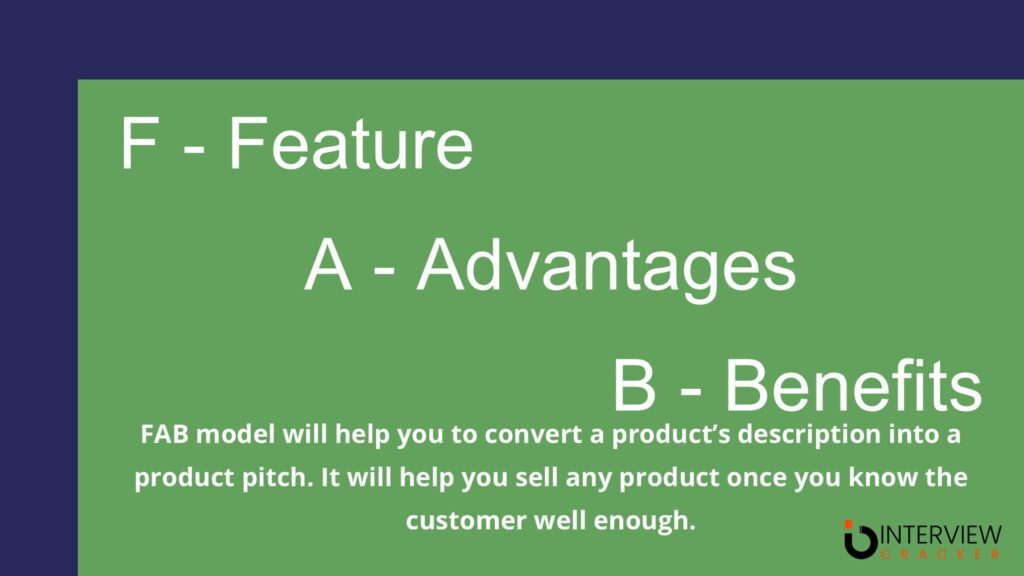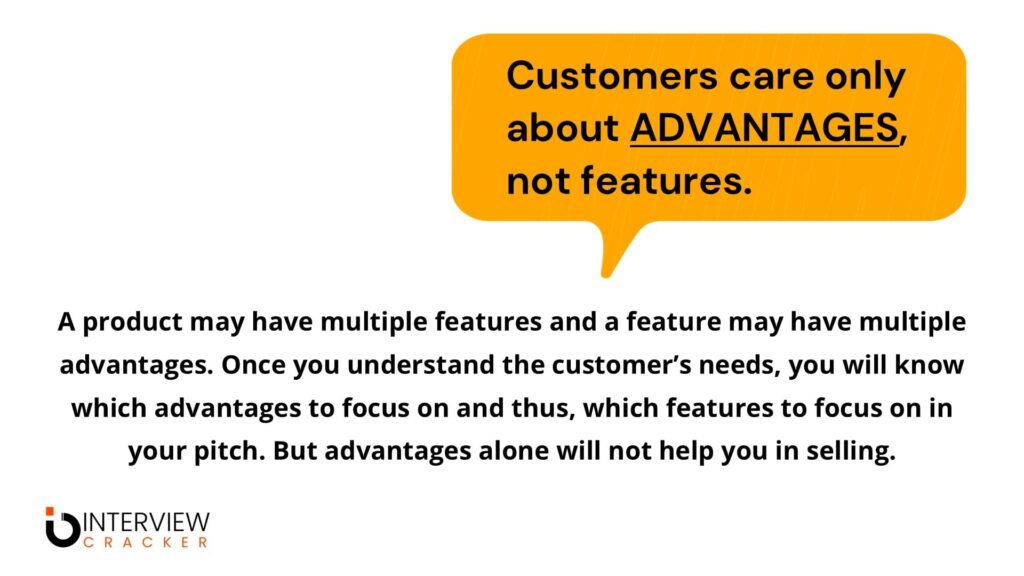What is FAB? | FAB Full Form in Sales
The FAB model stands for Features, Advantages, Benefits. It’s a proven sales technique designed to align products or services with customer needs by explaining their unique value. Widely adopted in markets like the USA, UK, and Canada, this method enhances customer engagement and boosts sales success. Below is a detailed exploration of the FAB technique for sales and how you can use it effectively.

FAB Framework | FAB model in Sales
Features:
These are the tangible or intangible characteristics of a product or service. Features are specification of a product. They are special points about the product which are generally better than the competitors.
Examples: A camera may have many features such as a single lense reflex, 18-135mm zoom lens and be 24 megapixel.
Note: Reciting features to customer never helps.
Advantages:
An advantage is what you get when you use a particular feature. Basically how the features improve performance or solve problems.
There are only 6 types of advantages that a feature can have and they are:
- A feature can save TIME.
- A feature can save MONEY.
- A feature can save EFFORT.
- A feature can give PLEASURE.
- A feature can build TRUST.
- A feature can improve SOCIAL STATUS.
Any feature can provide only some of the above advantages or a combination of it. You can convert any feature into an advantage easily.
For example:
The advantage of a 35 – 200mm lens is to enable you to zoom in or out using the one lense, enabling good shots to be take in a variety of situations, thus making the camera more flexible.

Benefits of FAB Techniques
Different customers gain different benefits. As a sales rep, we need to help customers to imagine how they will benefit from various advantages. Basically, Why the customer should care – the ultimate value to their lives or businesses with your product/services.
This is where “thinking on your toes/your ability to think quickly” comes into place. Combining user’s personality and need/ pain points, we can educate the customer on the advantages of the features that will in turn benefit him/her.
Example: So if we consider our feature of 24 megapixel then we can explain several benefits that the customer will get while taking photographs including a sharper image, ability to enlarge without losing quality, a better quality image overall.
Suggested Read: What makes a good sales pitch
Importance of the FAB Technique in Sales
- Customer-Centric Approach: FAB emphasizes the “why” for the customer, ensuring your pitch resonates.
- Boosts Clarity: Helps simplify complex offerings by breaking them into understandable terms.
- Improves Conversion Rates: Demonstrates clear value, making it easier for customers to decide.
Steps to Apply the FAB Technique
- Identify Customer Needs: Begin by researching their pain points and goals.
- Highlight Relevant Features: Showcase features that directly address their requirements.
- Showcase Advantages: Explain why these features are superior compared to competitors.
- Drive Home Benefits: Conclude by emphasizing the positive impact on the customer.
Example of FAB in Action
Product: Noise-Canceling Headphones
- Feature: Advanced noise-canceling technology.
- Advantage: Blocks 95% of ambient noise.
- Benefit: Enables undisturbed work and relaxation, even in noisy environments.
Adopting FAB for B2B and B2C Sales
The FAB method is versatile:
- B2B: Focus on how features improve operational efficiency and ROI.
- B2C: Highlight emotional and practical benefits, such as time-saving or enhanced lifestyle.
Suggested Read: Sales Motivation
Tips for Mastering FAB
- Tailor Your Approach: Customize FAB messaging for individual clients.
- Practice Active Listening: Understand client concerns before introducing your product.
- Use Storytelling: Create relatable scenarios to illustrate benefits effectively.
The FAB technique addresses prioritizing value by linking product attributes to practical solutions, making it a reliable tool for driving sales.
Conclusion
The FAB technique remains a cornerstone for effective sales strategies. By mastering the art of linking features, advantages, and benefits, sales professionals can build stronger connections, address customer pain points, and ultimately drive business growth in diverse markets.
Frequently Asked Questions (FAQs) About FAB Full Form and Technique
1. What does FAB stand for in sales?
FAB stands for Features, Advantages, Benefits. It’s a sales technique that highlights product attributes, their advantages, and how they benefit the customer.
2. Why is the FAB technique important in sales?
It simplifies product explanations, aligns offerings with customer needs, and improves conversion rates by clearly demonstrating value.
3. How do you use FAB in sales?
Identify customer needs, explain relevant features, showcase advantages, and emphasize how they benefit the customer.
4. Is the FAB technique effective for B2B sales?
Yes, it works well for B2B by linking product features to operational improvements, cost savings, and ROI.
5. Can FAB be used in B2C sales?
Absolutely. FAB helps in B2C by connecting product features to lifestyle improvements or emotional benefits.
6. What’s an example of the FAB model in practice?
For a fitness tracker:
- Feature: Tracks heart rate 24/7.
- Advantage: Provides continuous health monitoring.
- Benefit: Helps users achieve fitness goals safely.
7. How is the FAB technique different from traditional selling?
Traditional selling focuses on product features, while FAB emphasizes the customer’s perspective by linking features to advantages and benefits.
8. Who can benefit from using the FAB technique?
Sales professionals, marketers, and entrepreneurs in any industry aiming to communicate value effectively can benefit from the FAB method.
9. Is FAB relevant in digital sales?
Yes, FAB can be tailored for e-commerce and digital platforms to create compelling product descriptions that address customer pain points.
10. What are the common challenges in using the FAB model?
Challenges include identifying relevant features for diverse clients and effectively connecting advantages to measurable benefits.
11. How does FAB help in competitive markets like the USA, UK, and Canada?
It highlights value propositions clearly, helping businesses differentiate their products and resonate with customer priorities.
12. Are there tools to assist in creating FAB-based sales pitches?
Yes, CRM platforms, sales automation tools, and customer analytics software can support FAB strategies by providing insights into customer needs.

